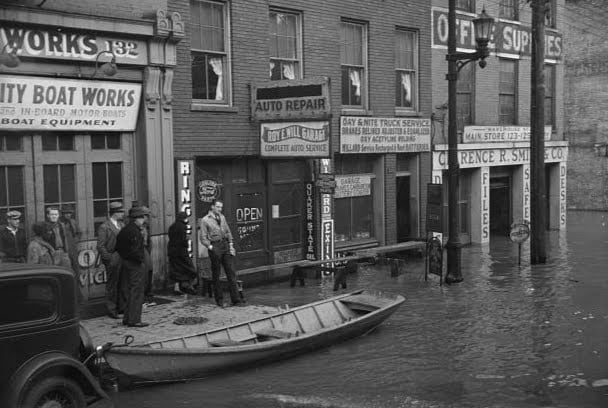The 1937 flood in Cincinnati (footage)

The Ohio River flood in Louisville, Kentucky.
In Cincinnati’s history, few events have left as indelible a mark as the Ohio River Flood of 1937. In the midst of the Great Depression, Cincinnati grappled with the flood. It reshaped its landscape and left a lasting impression on its people.
The entire Ohio River rose over its banks. Heavy rains and melting snow from the Appalachian Mountains fueled the flooding. The 1937 flood, left record flooding from Point Pleasant, WV down to the Ohio’s confluence with the Mississippi River at Cairo, IL. Many of these records still stand. The flood left an estimated 350 dead and around 1 million homeless.
The 1937 flood hits Cincinnati
The flood affected Cincinnati from January 18 to February 5. The river reached its peak on January 26. Crests were 20 to 28 feet (8.5 m) above flood stage and 4 to 9 feet (2.7 m) above the previous record of 1884. The flood left 12 square miles (31 km2) of the city underwater.
The waters swamped every precautionary barrier. Water poured into the waterworks, electrical stations, telephone switches, and gas lines. Railroad tracks submerged. Meanwhile, six inches of snow pounded the paralyzed city. Temperatures dipped to 20 degrees. Cincinnati residents shivered as coal piles soaked.
The flood ripped houses from their foundations. Also, rising waters forced people to take shelter in trees, while their beds floated away.
The Mill Creek valley was engulfed in flames after millions of gallons of gasoline ignited after a trolley line sparked.
In downtown Cincinnati, streets were filled with water. Crosley Field was flooded.
the Ohio River coursed through Downtown streets and filled Crosley Field like a bowl, flood survivors have regaled their children and grandchildren with tales of rowboat rescues, houses
The water submerged the amusement park Coney Island, where pieces of carousel horses floated away,. Some of the carousel horses were recovered as far downriver as Paducah, Kentucky.
Cincinnati’s Response
Dayton and Cleveland delivered potable water by truck.
The National Guard blocked access to downtown to stop looting. The mayor closed schools, theaters, and stores. Large-scale efforts from the Red Cross ensured that 50,000 refugees received medical attention and shelter. Meanwhile, the Boy Scouts rescued 92 people, 8 canaries, and 11 dogs. and medical care.
Grocery stores made deliveries by boat, while flood survivors continued to be rescued by good samaritans in rowboats.
The Federal Government’s response
In 1937, the federal government didn’t have any agencies designed to respond to flood disasters. There were no resources to help flood victims or to upgrade flood control.
However, the federal government under President Franklin D. Roosevelt sent thousands of WPA workers to the Ohio River area for rescue and recovery aid. After the floodwaters receded, the government sent millions of dollars of aid for the flood victims.
The disastrous Ohio River flood inspired civil and industrial groups to lobby the federal government for a plan for future flooding control. The federal government listened and created a plan that involved creating more than 70 storage reservoirs to reduce flood heights. The Army Corps of Engineers finished construction in the early 1940s. Since their creation, the new facilities have drastically reduced flooding.
Sources:
https://www.weather.gov/iln/1937OhioRiverFlood
https://www.cincinnati.com/story/entertainment/2016/01/28/remembering-flood-1937/79400064/




1 thought on “The 1937 flood in Cincinnati (footage)”